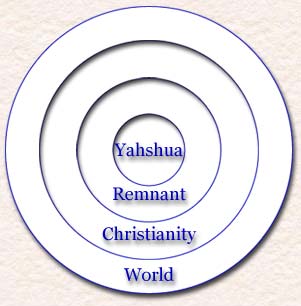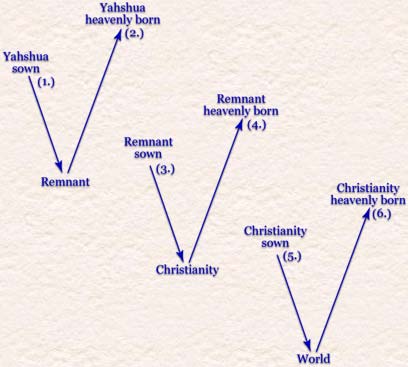
Seedtime and harvest,
seedtime and harvest, ...
CONT., page 3
EACH IN THEIR OWN ORDER
While Yahshua was sown in order to bring forth the fruit of the Remnant, the Remnant was sown in order to bring forth the fruit of Christianity. Then, Christianity will equally be sown in order to bring forth the fruit of the world. The outcome of this repeated process of sowing and reaping is an ever-widening circle of harvest. First Yahshua, then the Remnant, then Christianity, then the world.

Each successive planting results in an ever-increasing harvest. Yahshua is only one, the two-part Remnant is a small beginning, but with each increase the harvest becomes ever larger!
What must take place after Christianity is finished being sown into mankind over the next 3,000 years? Christians must then receive their heavenly-born bodies.
Throughout the Millennium and for 2,000 years afterward, Christians continue their labors while occupying earthly bodies. They will not receive their incorruptible bodies in the first resurrection, and will remain seed for planting for the sake of the world. But, when it is time for Yahshua to harvest the world, it is Christianity that will then enter into their incorruptible bodies, even as the Remnant received their incorruptible bodies at the harvest of Christianity. Thus, sowing results in two things - (1) a harvest to Yahweh's increase in the heavenly born, as well as (2) seed to be sown.
When Christianity enters into incorruptible bodies, there will then be two companies who will have entered into these heavenly-born immortal bodies - the first resurrection two-part Remnant, as well as Christianity. This is the holy of holies and the holy place of Yahweh's two-part temple. But as a result of Christianity being sown into the world, the world will be saved, even as Christianity was saved by the Remnant's sowing, thus affording Yahweh His outer court. In each case, the former is sown for the sake of the next:
Let us illustrate this process in the following way. What we see in this illustration is that the preceding work is sown into the one that follows - Yahshua into the Remnant, the Remnant into Christianity, and Christianity into the world - with the outcome that at the harvest of the latter, the former "seed crop" is then caught up into heaven to be "born from above," having completed its intercessoral seed work, even as did Yahshua
.
We find in the Scriptures that these various resurrections are enumerated in different ways. Sometime one resurrection is cited, sometime two, most often three, but sometime even all four. Let us see what we mean by this. We will begin with a reference to what Revelation 20:4-6 identifies as the "first resurrection" of man, but included is Yahshua's preceding initiating resurrection as well.
In 1 Corinthians 15: 20-24 we read, beginning with the first two verses:
But now Christ has been raised from the dead, the first fruits of those who are asleep. For since by a man came death, by a man also came the resurrection of the dead.
Thus we see that one man, Yahshua, was the initiating first man to enter into resurrection. He was the first fruits of resurrection. But the next verses do not address all of the resurrections that follow; instead, they only consider those who will be in the "first resurrection" - the resurrection of the two-part Remnant. These will reign with Yahshua for 1,000 years in the Millennium at His coming, and are addressed in these verses in such regard. Let us continue reading.
For as in Adam all die, so also in Christ all shall be made alive. But each in his own order: Christ the first fruits, after that those who are Christ's at His coming (the accompanying Remnant), then comes the end, when He delivers up the kingdom to the God and Father, when He has abolished all rule and all authority and power.
The two-part Remnant will reign with Yahshua during the Millennium when He will sit on the throne of David here on earth, abolishing all presently existing "rule and all authority and power." So here in 1 Corinthians 15 we see the initiating resurrection of Yahshua, the first fruits, followed by those who accompany Him at His coming - the "first resurrection" two-part Remnant.
Though this verse does indeed identify the fact that resurrection must occur "each in his own order," the only resurrections cited here are those of Yahshua and the Remnant. But we know that resurrection is not limited to these only. We know there will be subsequent resurrections as well, and the Scriptures equally identify them. "Each in his own order" must extend beyond these first two resurrections in order for the immediately preceding verse to be fulfilled - "in the Christ all shall be made alive."
Obviously, with these two resurrections not all are "made alive," for there are a host of others who must equally join Yahshua and the Remnant into resurrection. In what order will they join them? In the order we have already addressed in this writing, and as we will now see confirmed in other revealing patterns as well.
We have already briefly mentioned one of these patterns - the two-part temple and its outer court. Here we see Yahweh's plan to establish not only the two-part temple of the two-part church - the Remnant's holy of holies, as well as Christianity's holy place - but also the outer court of the nations. In Revelation 11:1-2 we read:
And there was given me a measuring rod like a staff; and someone said, "Rise and measure the temple of God, and the altar, and those who worship in it (i.e., the tithe out of all mankind - the two-work church). And leave out the court which is outside the temple, and do not measure it, for it has been given to the nations."
The two preceding resurrections of the Remnant and Christianity, composing the two-part temple, must then be followed by the third resurrection of the nations, adding the outer court. The first two resurrections comprise the church, the kingdom of God, the bride and the groom, the olive trees and the lampstand, the works that are not by might nor by power but by Yahweh's Spirit. These are the two works measured here; and the nations were not measured, though obviously given a place around the temple/the church.
And as was just eluded by the identification of these two works as being the bride and the groom, this wedding of the two must also have its many guests. Though these guests are not measured as a part of the uniting bride and groom, they nonetheless must be brought into the temple proximity, and in time will enter into their own resurrection. The nations, though not a part of the temple, are given the rights to the outer court - "it has been given to the nations." In their own order, the nations will likewise enter into immortality, completing the temple area by adding the necessary outer court.
Another way Yahweh reveals His three-part resurrection is through the order of the feasts. The first resurrection is the unleavened Passover resurrection of the two-part Remnant. The second resurrection is the leavened Pentecost resurrection of the body of Christ. And the third resurrection is the Tabernacles resurrection of the nations. So we see Passover, Pentecost, and Tabernacles resurrections.
These three resurrections follow three distinct and feast appropriate harvests as well: the first resurrection Remnant barley harvest, the second resurrection Christianity wheat harvest, and the third resurrection nations grape harvest. The Remnant barley is separated from its chaff with light abrasion. On the other hand, Christianity wheat is more tightly attached to its chaff and must be beat in order to separate it. Then finally, the nations grapes must be crushed and trodden under foot in order to complete their harvest. Thus here we see barley, wheat, and grape resurrections.
A third pattern of these three resurrections are three livestock. First is the resurrection of the oxen, the two-part Remnant. Second is the resurrection of the sheep, Christians who are divided two-thirds and one-third in Zechariah 13:7-9. And third is the resurrection of the goats, the nations. So we find the oxen, sheep, and goat resurrections.
Another witness to this order is found in the great statue which Daniel not only told the interpretation regarding, but also revealed Nebuchadnezzar's dream about it. In this pattern, Yahshua's resurrection is included; so here we find not two, not three, but truly all four resurrections. The head of gold is the resurrection of the Head, Yahshua, who provides the gold of the kingdom. The second resurrection is the resurrection of the two-part Remnant, the breasts and arms of silver (silver is identified with the Remnant). The third resurrection is the resurrection of Christians, the belly and thighs of bronze (the belly and bronze = Christianity). Then finally, the fourth resurrection is the resurrection of the nations, or the legs of iron and feet partly of iron and partly of clay (iron = nations). The like three are the breast, belly, and legs resurrections, or even the silver, bronze, and iron resurrections.
And let us recall the three resurrections we began this with - the holy of holies, the holy place, and the outer court resurrections.
Yahweh thus provides us consistent, repeated, testimony upon testimony of these three resurrections of mankind, each in their own order.
Continue to page 4 of Seedtime and Harvest for THE SAVIORS WILL ASCEND